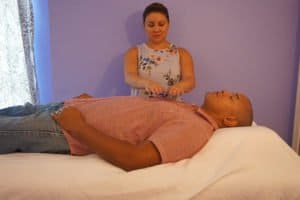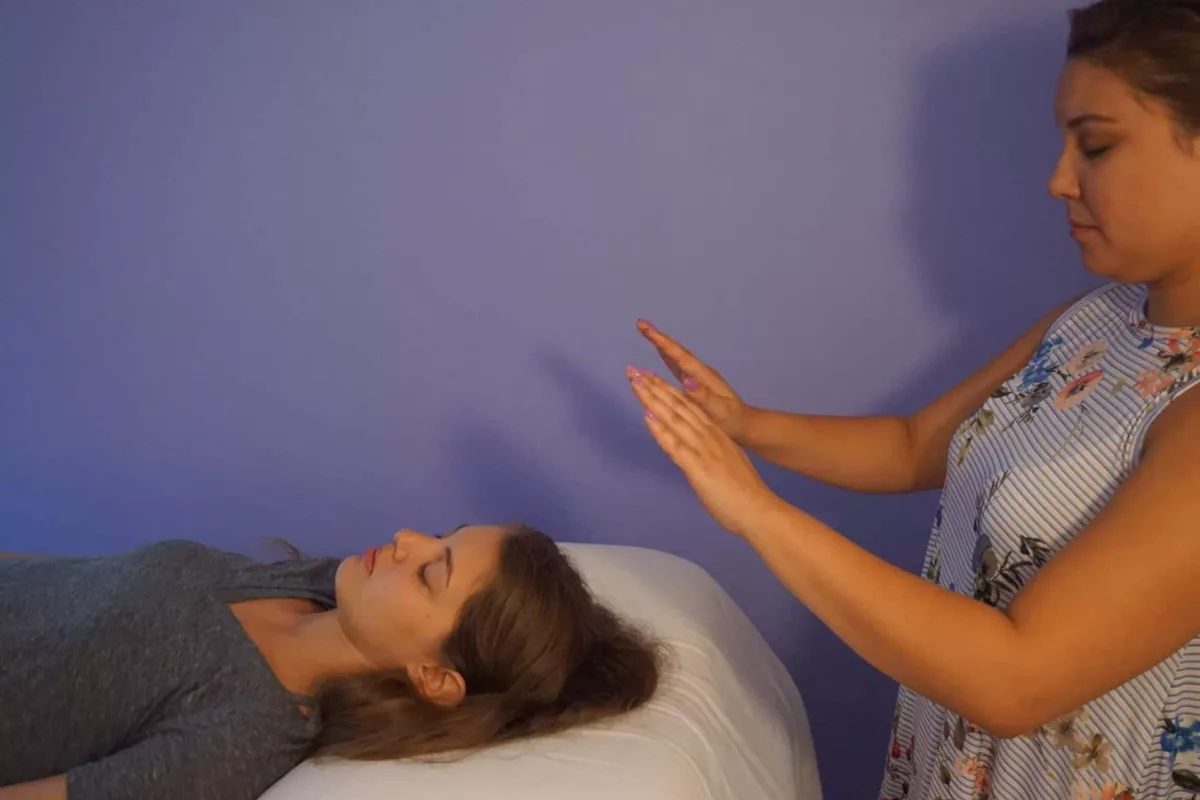What is Reiki?
The general population often confuse Reiki with massage as many massage therapist have incorporated Reiki (Ray-Kee) into their massages. To clarify, Reiki is not a form of massage. There is no kneading, pressing, pushing, or manipulation of muscles of the client in a Reiki session whatsoever.
Your First Reiki Session
Reiki is what one would dub an “experiential” service. At first, most people aren’t really even sure how to describe what it is into words, and instead can generally only verbalize how they felt before, during, and after their Reiki session. Many experience Reiki similarly. Clients often report during their session that they experience Reiki as bright colors even though their eyes are closed. Many report feeling calm, relaxed, and at peace. And others just fall asleep, and arise with feeling of the weight of world being lifted from their shoulders. Generally the overall feedback is the same: I feel better!
The profound benefits of Reiki are experienced by the client through the gentle and light touch of the practitioner’s hands, and in many cases with no touching of the person at all. Yes, you read that correctly. Reiki healing can be done WITHOUT touch. Reiki can be practiced over the phone, video chat, or with no communication link at all. As a result, this has allowed the Art of Reiki to evolve into a more flexible option than say massage, which requires in person contact. I’ve done Reiki on clients as far as California and Ohio, with the same result as someone who would be laying on the table in my office in Alexandria, Virginia. Reiki has also become a viable option for those who are not comfortable with physical touch.
How Can one Feel Stuff Without Being Touched?
Reiki is simply the movement of universal life energy from the practitioner’s hands to the client. After receiving their Reiki attunements the practitioner has the ability to flow the Reiki from their hands to the client’s body. It is not something that can be seen necessarily by the client but can be felt.
Together, the client’s energy and the Reiki energy work to achieve balance in a client’s mental, emotional, physical, and spiritual bodies. Also, Reiki does not require any religious belief, no dogma, nor does Reiki worship any guru, yogi, or leader. Dr. Usui is recognized and honored as the Founder, but that’s it. All Reiki (Ray-Kee) requires is a client’s willingness to heal.
How would Reiki benefit athletes and athletic performance?
Reiki is advantageous for athletes, as it is another modality that could be utilized to heal and recover muscles, achieve mental clarity and/or relieve anxiety around an athletic competition, or mental stress in general.
For athletes who are on the mend from an injury or surgery Reiki can be used to accelerate the healing of injuries. Furthermore, since Reiki can be practiced on a client without touch, clients have the peace of mind knowing they are receiving healing without being pushed into more physical discomfort. For example, one of my client’s Martha, suffered from neuropathy in her hands and feet. After a few reiki sessions, she has hardly noticed her neuropathy at all. Another example, was my client Jenn with a torn meniscus. Although her knee was tender to touch, I could hover my hands above her knee and still deliver the Reiki healing energy without putting her in further discomfort.
Moreover, Reiki does not require constant maintenance. Each time a client receives Reiki the healing energy stays with the client longer and longer each time they receive it. To illustrate, I have worked on many clients with anxiety and after 1-4 sessions over the course of 2-3 months they felt marked improvement and see me on as a needed basis every 3-6 months.
Preparing for your Reiki Session
Reiki can be performed fully clothed. To illustrate, I used to practice on soldiers at Ft. Belvoir. Often times there was no times to remove boots. Yes, if a soldier can still feel Reiki through a military issued boot, you will certainly feel it through your clothes. Also, Reiki has now become a viable option in helping soldiers and veterans work through TBI and PTSD.
- You can expect your practitioner to greet you and show you the bathroom and offer you water. Many Reiki practitioners are good folks who are pretty friendly and understanding. Also, your first session may be significantly longer than your first. For example, all of my First-time Reiki sessions are 2 hours.
- Generally, you will fill out an intake form, then usually chat.
- Your practitioner will either a) explain what Reiki is to you first THEN ask what your needs are or b) ask what your needs are and then explain Reiki.
- You can expect to lay down face up on a massage table or lounger, or upright in a chair. I prefer Reiki laying down, but whatever you prefer. If you have issues laying flat let your practitioner know beforehand so they can accommodate you in advance.
- They will generally dim the lights depending on the venue.
- Where you practitioner begins on clients varies. I was trained to begin from head down to toes and back up to the head. Others work from toes to head. Others go right to where they sense energy blockages first. It just depends on the practitioner.
- Many practitioners will incorporate essential oils, pendulum, aromatherapy, singing bowls, and crystals into their sessions. This is totally normal and assist the practitioner in opening your energy centers. If you do not prefer any of these items in your session let your practitioner know beforehand during your intake.
- Most likely you will fall asleep, or feel calm and relaxed. How you experience Reiki is completely unique to you!
Finding A Reiki Practitioner And What You Can Expect To Happen In A Reiki Session
 The Reiki community has grown extensively in the past few years since I began back in 2011. As Reiki can only be passed from a Certified Reiki teacher to student, one cannot just pick up a book at the bookstore and begin Reiki. If seeking Reiki, one should look for the following: A Certified Reiki Practitioner, and commonly the practitioner will state their level on their website or business card. If not, ask.
The Reiki community has grown extensively in the past few years since I began back in 2011. As Reiki can only be passed from a Certified Reiki teacher to student, one cannot just pick up a book at the bookstore and begin Reiki. If seeking Reiki, one should look for the following: A Certified Reiki Practitioner, and commonly the practitioner will state their level on their website or business card. If not, ask.
There are 3 levels to Reiki:
- Reiki Level 1- Have received their Reiki Level 1 Attunement. They can practice on self and close family and friends. Generally, practitioners should not be charging for Reiki at the Reiki 1 level.
- Reiki Level 2- The practitioner has received the Reiki Level 2 attunement, assumed to be properly trained in client ethics, practiced a certain amount of hours on others (hours are at discretion of instructor). Practitioners may begin their practice and charging for their services.
- Reiki Level 3: Has received all of the above including their Reiki Master-Teacher Attunement. They are certified to pass the Reiki attunement to students, perform distance Reiki, and eloquently educate others what Reiki is and is not.
*Important to note that age and level play no role of importance in how well a Reiki session will be. Intent matters, Level does not.
Price Points
Reiki Master-Teachers will generally charge significantly more than Reiki Level 2 students. Reiki Level 1 students are not encouraged to charge for their services. You can expect to pay $80-$250 for Reiki depending on your geographic location and years of experience of the practitioner. Unfortunately, Reiki is not covered by insurance at this point in time. Although clients are welcome to submit receipts of their Reiki session for FSA, practitioners make no guarantees it will be reimbursed by your employer. More importantly, Reiki is it not a substitute for professional medical care, although it can be a beneficial supplement.
Sand & Steel would like to thank Meredith McDonough of Higher Vibrations for her assistance in writing this post.

Your mode of telling the whole thing in this piece of writing is really fastidious,
every one be capable of effortlessly know it, Thanks a lot.
Hurrah! In the end I got a blog from where I be able to genuinely obtain valuable facts concerning my study and
knowledge.
Thanks for reading our blog! Welcome to Sand & Steel.
If you want to grow your knowledge simply keep visiting this web page and be updated with the newest gossip posted here.
My partner and I stumbled over here different web address
and thought I may as well check things out. I like what I see so i am just following you.
Look forward to looking over your web page repeatedly.
I’ve been exploring for a little for any high
quality articles or blog posts on this sort of house . Exploring in Yahoo I finally stumbled upon this
site. Reading this info So i’m happy to show that I’ve a very just
right uncanny feeling I found out exactly what I needed. I such a lot for sure will make certain to don?t disregard this site and provides it
a look on a relentless basis.